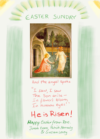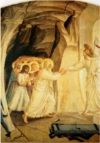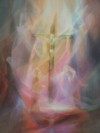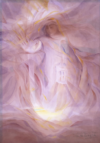Saturday
Saturday:
0 you fire, O you light,
Help me, that in the dark house
The light of Your light shine,
lightening all darkness;
Your warmth glow through it,
O you fire, O you light!
-Sophie Michaelis
Saturday
-Adam Bittleston
O Christ, I remember with love and thankfulness
Those I have known
Who have passed through the gate of death.
I know that some of these have looked on my soul
From the realm in which their souls dwell.
I thank Thee for all I have received from them;
For Thou hast brought our lives to meet.
May my thoughts and feelings reach unto them through Thee;
May they add warmth and purpose
To my earthly life.
And may my meeting again with them
Be blessed by Thee.
Friday
Friday:
You live in secret
and fill all your creatures
you work and reign
everything upon everything
and reveal yourself
In tenderness and beauty.
–Sophie Michaelis
Friday
–Adam Bittleston
Let me remember the servants of Christ
Who kept in their hearts
His will for the world.
Beneath the Cross, the beloved disciple
Winning from pain eternal patience,
Beholding in darkness the new beginning.
Paul, who endured all persecution,
Rejoicing in the freedom of the Christian soul.
Columba, through the dark and the cold
Journeying to build a faithful brotherhood.
Francis, overcoming the fear of leprosy,
And raising our vision to the beauty of earth.
Elizabeth, bringing red roses
Into the depths of need.
The work of the servants of Christ
Holds in it sure promise
For the future of earth.
May we protect
What they have planted.
Their power live
In words and deeds of ours.
Thursday:
You who open your clouds
and let your raindrops fall,
Work within us
the miracle of change,
that your earth
receive the waters of life
and its form be renewed.
–Sophie Michaelis
Thursday
–Adam Bittleston
O Christ, Thou readest
The living book of human destiny.
In all who come to Thee
Thou knowest the inmost soul,
The body’s need, the spirit’s seeking.
In my thought of human beings
May I receive Thy light.
In my experience of human deeds
May I feel Thy will.
May we all, as Thy Community,
Find the right ways
For human souls
Who will to serve Thy Spirit.
.
Wednesdays
Wednesday:
Lord, You pass over us,
before we even realize it.
You are transforming Yourself,
before we notice it.
— from the Book of Job
Wednesday
–Adam Bittleston
Upon the temple of our body
Worked through the ages
The servants of God
Mighty spiritual creators.
This is now my dwelling;
But it is darkened
By the power of tempters
To whom my soul has listened.
O Christ, against Thee
The voice of temptation
Could achieve nothing.
Thou art the healer
For all our sickness.
Work in this body
That all of its elements,
Its warmth and its breath
Its quickening blood,
The bones which sustain
The form which God gave
Be hallowed by Thee.
Mondays
Monday:
You are the source of life,
and in Your light.
we see the light.
–from Psalm 36
Monday
–Adam Bittleston
When we go out into the world as we have made it
Everywhere there speaks to us forgetfulness of the Spirit.
If human work were to be without love
The earth would become a bleak and barren desert.
Through forgetfulness of the Spirit
Love ebbs away.
Bring to mind in us, O Christ,
Inspirer of true human love,
How we have come to the earth
From fields of light,
From the heights of the Spirit.
May we bring to earth
What we have seen in the Spirit.
May remembrance of God
Grow strong in our souls
Overcoming the mists
Which hide the meaning
In the work of each day.
At Sea
John 6:16–21
When evening came, his disciples went down to the lake, where they got into a boat and set off over the sea for Capernaum. By now it was dark, and Jesus had not yet come to them. A strong wind was blowing and the waters grew rough. When they had rowed three or three and a half miles, they saw Jesus approaching the boat, walking on the sea; and they were terrified. But he said to them, “I AM, have no fear” Now when they wanted to take him into the boat, immediately the boat was at the land, at the place where they wanted to go.
2nd Passiontide
March 18, 2020
John 6:16–21
Cynthia Hindes
This gospel reading has the quality of a dream. It starts as something of a nightmare. It is night; the disciples are in a boat, working hard to make headway in rough seas. Suddenly they see Christ. He appears as if walking, a shining form above the waters. At first, they shrink with fear, but he calms them with the assurance of his very being – it is I. And when they take him in, they are suddenly at their destination.
Our lives, too, are sometimes beset with darkness and rough passages. It is just at those times when Christ can make his ever-presence known to us. He assures us that fear can be dispelled because he is the helping Guide on our journey. With his aid, we will reach our goal of firm grounding.
Not only is he our guide for the way, but he is also our bread for the way. Just as after a night on the sea of dreams, we come to the daytime shore refreshed, so too does Christ nourish our spirits. He gives our spirits life and strength. He comes to us, we who trust that we will survive with him, even in the darkest hours. Perhaps, like Rilke, we can also learn to love them. He says,
I love the dark hours of my being.
My mind deepens into them.
There I can find, as in old letters,
the days of my life, already lived,
and held like a legend, and understood.
Then the knowing comes: I can open
to another life that’s wide and timeless.*
*Ranier Maria Rilke in Rilke’s Book of Hours: Love Poems to God, trans. by Anita Barrows and Joanna Macy
Prayers for Strength
A Prayer for Strength
The Soul’s longings are like seeds,
Out of which deeds of will are growing
And life’s fruits are ripening.
I can feel my destiny and my destiny finds me.
I can feel my star and my star finds me.
I can feel my aims and my aims are finding me.
The World and my soul are one great unity.
Life grows brighter around me
Life becomes harder for me
Life will be richer within me.
— Rudolf Steiner, PRAYERS AND GRACES, p. 74.
A Prayer to the Nine Ranks of Gods
In the weaving of the ether
Man’s web of destiny
Is received by Angels, Archangels, Archai.
Into the astral world
The just consequences of man’s earthly life
Die into Exousiai, Dynameis, Kyriotetes.
In the essence of their deeds
The honest creations of man’s earthly life
Are resurrected in Thrones, Cherubim, and Seraphim.
— Rudolf Steiner, PRAYERS AND GRACES, p. 62.
Coronation
Coronation–Feb 2, 2020
–Rev. Gisela Wielki
A corona is a circle of light around an object. The most magnificent corona in our universe is the corona around the sun. It is a fiery circular crown with occasional intense flare-ups. Its rays extend millions of miles into space. What a majestic body our sun is, the source of light and of life.
Looking at the heart, there is also a corona. The heart muscle has its own blood supply. It comes from a crown or corona of blood vessels that circle the heart. This corona can be defective, and then one speaks of coronary heart disease.
And now we have a corona-virus that has unleashed panic around the globe. Borders have been closed. Air travel has been partially suspended. Millions of people are under lockdown. The corona-viruses are named for the crown-like spikes on the surface of the virus. They usually cause mild to moderate upper-respiratory infections, like the common cold. But they can also cause more severe illnesses such as bronchitis and pneumonia, which can, of course, lead to death.
For some time now, people all over the world seem to have fallen under the spell of fear. Fear has entered our lives like a fast-spreading virus. It has become a corona of darkness around the globe. Like the crown-like spikes of the corona-virus, the dark spikes of fear drive people apart. Fear drives people into isolation. Fear contracts and constricts the heart.
And is the heart of humanity not suffering from coronary heart disease, from constriction, and therefore from a lack of love supply? Infectious love and life and laughter are giving way to deadly infections of the soul and the spirit. The world needs healing. We need healing.
As I child I used to sing: ‘The Sun is in my heart …’ We need to re-discover the sun-being in our hearts, in our midst, so that His corona can embrace our frightened humanity and drive away the cold and dark corona of fear, and so that we may find the courage to touch each other’s soul with the contagious healing power of love.
Against Fear
May the events that seek me
Come unto me;
May I receive them
With a quiet mind
Through the Father’s ground of peace
On which we walk.
May the people who seek me
Come unto me;
May I receive them
With an understanding heart
Through the Christ’s stream of love
In which we live.
May the spirits which seek me
Come unto me;
May I receive them
With a clear soul
Through the healing Spirit’s Light
By which we see.
–by Adam Bittleston






